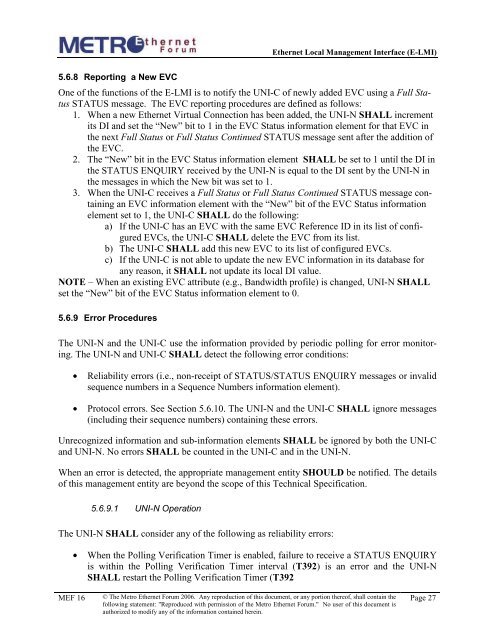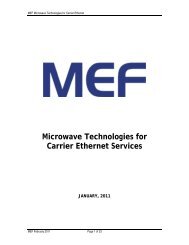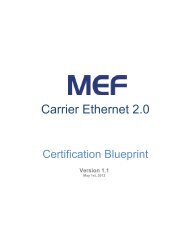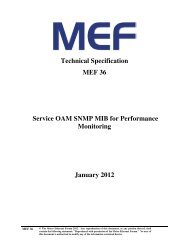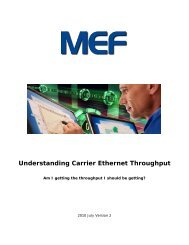Technical Specification MEF 16 Ethernet Local Management Interface
Technical Specification MEF 16 Ethernet Local Management Interface
Technical Specification MEF 16 Ethernet Local Management Interface
You also want an ePaper? Increase the reach of your titles
YUMPU automatically turns print PDFs into web optimized ePapers that Google loves.
<strong>Ethernet</strong> <strong>Local</strong> <strong>Management</strong> <strong>Interface</strong> (E-LMI)<br />
5.6.8 Reporting a New EVC<br />
One of the functions of the E-LMI is to notify the UNI-C of newly added EVC using a Full Status<br />
STATUS message. The EVC reporting procedures are defined as follows:<br />
1. When a new <strong>Ethernet</strong> Virtual Connection has been added, the UNI-N SHALL increment<br />
its DI and set the “New” bit to 1 in the EVC Status information element for that EVC in<br />
the next Full Status or Full Status Continued STATUS message sent after the addition of<br />
the EVC.<br />
2. The “New” bit in the EVC Status information element SHALL be set to 1 until the DI in<br />
the STATUS ENQUIRY received by the UNI-N is equal to the DI sent by the UNI-N in<br />
the messages in which the New bit was set to 1.<br />
3. When the UNI-C receives a Full Status or Full Status Continued STATUS message containing<br />
an EVC information element with the “New” bit of the EVC Status information<br />
element set to 1, the UNI-C SHALL do the following:<br />
a) If the UNI-C has an EVC with the same EVC Reference ID in its list of configured<br />
EVCs, the UNI-C SHALL delete the EVC from its list.<br />
b) The UNI-C SHALL add this new EVC to its list of configured EVCs.<br />
c) If the UNI-C is not able to update the new EVC information in its database for<br />
any reason, it SHALL not update its local DI value.<br />
NOTE – When an existing EVC attribute (e.g., Bandwidth profile) is changed, UNI-N SHALL<br />
set the “New” bit of the EVC Status information element to 0.<br />
5.6.9 Error Procedures<br />
The UNI-N and the UNI-C use the information provided by periodic polling for error monitoring.<br />
The UNI-N and UNI-C SHALL detect the following error conditions:<br />
• Reliability errors (i.e., non-receipt of STATUS/STATUS ENQUIRY messages or invalid<br />
sequence numbers in a Sequence Numbers information element).<br />
• Protocol errors. See Section 5.6.10. The UNI-N and the UNI-C SHALL ignore messages<br />
(including their sequence numbers) containing these errors.<br />
Unrecognized information and sub-information elements SHALL be ignored by both the UNI-C<br />
and UNI-N. No errors SHALL be counted in the UNI-C and in the UNI-N.<br />
When an error is detected, the appropriate management entity SHOULD be notified. The details<br />
of this management entity are beyond the scope of this <strong>Technical</strong> <strong>Specification</strong>.<br />
5.6.9.1 UNI-N Operation<br />
The UNI-N SHALL consider any of the following as reliability errors:<br />
• When the Polling Verification Timer is enabled, failure to receive a STATUS ENQUIRY<br />
is within the Polling Verification Timer interval (T392) is an error and the UNI-N<br />
SHALL restart the Polling Verification Timer (T392<br />
<strong>MEF</strong> <strong>16</strong><br />
© The Metro <strong>Ethernet</strong> Forum 2006. Any reproduction of this document, or any portion thereof, shall contain the<br />
following statement: "Reproduced with permission of the Metro <strong>Ethernet</strong> Forum." No user of this document is<br />
authorized to modify any of the information contained herein.<br />
Page 27


